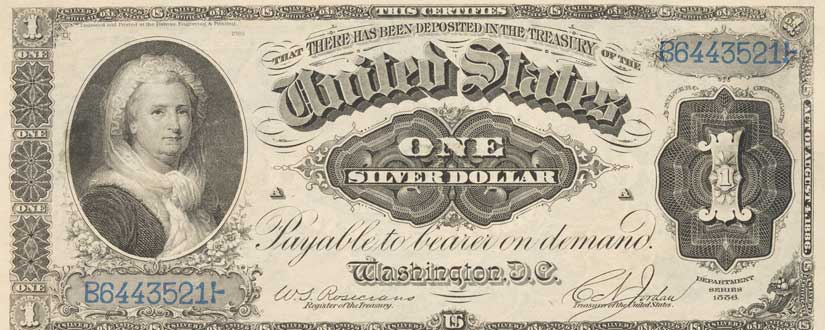Women Making Their Economic Marks from the Labor Force to Pop Culture
Fed resources offer a view of women in economic history, from their participation in the labor force to their leadership in the economics field—and from Martha Washington’s appearance on 1886 currency to Taylor Swift’s appearance in a 2023 summary of commentary on current economic conditions.
We’ve rounded up a few selections for you to explore in honor of Women’s History Month and invite you to delve into the wealth of information from our Economic Education team, the FRASER digital library, and the St. Louis Fed’s Economy Museum, among others.
Women at Work
The Women’s Bureau at the U.S. Department of Labor and its predecessor have studied U.S. women workers’ roles for over a hundred years, and women have been involved in the nation’s labor force for much longer than that—since the nation’s earliest days, as a March 2019 post on the Inside FRASER blog noted. The blog highlights resources in FRASER, a digital library of U.S. economic, financial and banking history. A number of blog posts provide a historical look at women’s roles in the economy from dressmaking to office work, as featured in a September 2018 post, and women who have worked at the U.S. Treasury, as highlighted in a March 2022 post.
For more current trends, check out The FRED Blog, which has harnessed the power of online database FRED to look at everything from the value of women’s unpaid work to why women’s employment changes with the seasons. (See the FRED chart below.)

Women’s Economic Connections in Pop Culture
Sometimes one woman doing her job boosts the economy in newsworthy fashion. That’s what Taylor Swift, with the help of her fans, is credited with doing last year via “The Eras Tour.” The effect of the pop star’s May 2023 concert dates on one industry in Philadelphia merited a mention in the Federal Reserve Bank of Philadelphia’s report (PDF) for the Fed’s June 2023 Beige Book, which is intended to add anecdotal context to other data and analysis economists use to gauge how the economy is doing.
“Despite the slowing recovery in tourism in the region overall, one contact highlighted that May was the strongest month for hotel revenue in Philadelphia since the onset of the [COVID-19] pandemic, in large part due to an influx of guests for the Taylor Swift concerts in the city,” the report said.

The “Barbie” movie also was a big pop culture hit last year. For decades before the movie came out, the doll has affected how kids think about the kinds of careers women can have. The “Barbie in the Labor Force” lesson from the St. Louis Fed’s Econ Ed team pairs a timeline of the doll’s careers with historical information about women’s occupations and labor force participation.
The lesson includes primary source documents from FRASER, like the following chart from a 1960 Women’s Bureau “Highlights” report.

A chart from a 1960 Women’s Bureau “Highlights” report showed men’s and women’s shares of the labor force starting in 1920 and projecting the shares in 1970. The report is a primary source document from online digital library FRASER featured in the “Barbie in the Labor Force” lesson.
Women Represented on Coins and Cash
In March last year, the Open Vault blog highlighted some of the past and future currency that honors women, including one-dollar silver certificates from 1886 and 1891 featuring Martha Washington’s portrait. Washington was “the first woman in U.S. history to receive major depiction on currency issued by the Bureau of Engraving and Printing,” per a June 2022 Inside FRASER post. The St. Louis Fed’s Economy Museum has some of the historic currency in its collection.

This 1886 one-dollar silver certificate is part of the Economy Museum’s rotating collection.
The currency on display changes regularly, and the museum now has an online “Collections Vault” to show some of the off-display currency.
Women Making History in Economics
Guests on the St. Louis Fed’s Women in Economics Podcast Series have ranged from economics students and professors to members of the Federal Reserve Board of Governors.

From left, economists Fenaba Addo, Daria Sevastianova and Una Osili gave interviews for the Women in Economics Podcast Series.
The series, which began in 2018, highlights the research and careers of those making their marks in the economics field and has featured many of the notable speakers from the annual Women in Economics Symposium. See the box for information on signing up for this year’s event.
The Inside FRASER blog has featured women who played historic leadership roles in the economics field in the 20th century, like Nellie Tayloe Ross, who was the first woman to serve as director of the U.S. Mint. The blog post also highlights Elizabeth Duncan Koontz and Carmen Rosa Maymi, pictured below, who were the first Black and Hispanic directors, respectively, of the Department of Labor’s Women’s Bureau. Another Inside FRASER post has featured women who have served on the Federal Open Market Committee.

Elizabeth Duncan Koontz (left) and Carmen Rosa Maymi served as directors of the Women’s Bureau. Images via FRASER and excerpted from “Milestones: The Women’s Bureau Celebrates 65 Years of Women’s Labor History,” a 1985 Women’s Bureau publication.
This blog explains everyday economics and the Fed, while also spotlighting St. Louis Fed people and programs. Views expressed are not necessarily those of the St. Louis Fed or Federal Reserve System.
Email Us



